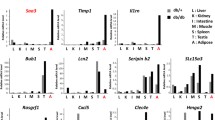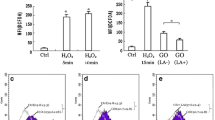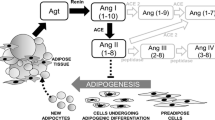Abstract
Hypoxia has been implicated as a possible cause of adipose tissue inflammation. Furthermore, the acute phase protein serum amyloid A (SAA) has been associated with the modulation of the adipogenic process, and it is well-known that obese individuals have increased levels of SAA. The effect of hypoxia in the expression and production of SAA was examined in murine 3T3-L1 adipocytes. Hypoxia leads to a substantial increase in SAA3 mRNA and protein level, apparently in a time-dependent manner (threefold in 48 h), in fully differentiated 3T3-L1, followed by reestablishment of gene expression to basal levels after 24 h of reoxygenation. Hypoxia-induced SAA may be one of the key molecules to the development of the inflammatory response in adipose tissue.

Similar content being viewed by others
References
Regazzetti, C., P. Peraldi, T. Gremeaux, R. Najem-Lendom, I. Ben-Sahra, M. Cormont, et al. 2009. Hypoxia decreases insulin signaling pathways in adipocytes. Diabetes 58: 95–103.
Ye, J. 2009. Emerging role of adipose tissue hypoxia in obesity and insulin resistance. International Journal of Obesity 33: 54–66.
Hotamisligil, G.S. 2006. Inflammation and metabolic disorders. Nature 444: 860–7.
Trayhurn, P., B. Wang, and I.S. Wood. 2008. Hypoxia in adipose tissue: a basis for the dysregulation of tissue function in obesity? British Journal of Nutrition 100: 227–235.
Poitou, C., N. Viguerie, R. Cancello, R. De Matteis, S. Cinti, V. Stich, et al. 2005. Serum amyloid A: production by human white adipocyte and regulation by obesity and nutrition. Diabetologia 48: 519–528.
Furlaneto, C.J., and A. Campa. 2000. A novel function of serum amyloid A: a potent stimulus for the release of tumor necrosis factor-alpha, interleukin-1 beta, and interleukin-8 by human blood neutrophil. Biochemical and Biophysical Research Communications 268: 405–408.
Sandri, S., D. Rodriguez, E. Gomes, H.P. Monteiro, M. Russo, and A. Campa. 2008. Is serum amyloid A an endogenous TLR4 agonist? Journal of Leukocyte Biology 83: 1174–1180.
Filippin-Monteiro, F.B., E.M. de Oliveira, S. Sandri, F.H. Knebel, R.C. Albuquerque, and A. Campa. 2012. Serum amyloid A is a growth factor for 3T3-L1 adipocytes, inhibits differentiation and promotes insulin resistance. International Journal of Obesity 36: 1032–9.
Faty, A., P. Ferre, and S. Commans. 2012. The acute phase protein serum amyloid A induces lipolysis and inflammation in human adipocytes through distinct pathways. Plos One 7(4): e34031. doi:10.1371/journal.pone.0034031.
Sommer, G., S. Weise, S. Kralisch, P.E. Scherer, U. Lossner, M. Bluher, et al. 2008. The adipokine SAA3 is induced by interleukin-1 beta in mouse adipocytes. Journal of Cellular Biochemistry 104: 2241–2247.
Ye, X.Y., Y.M. Xue, J.P. Sha, C.Z. Li, and Z.J. Zhen. 2009. Serum amyloid A attenuates cellular insulin sensitivity by increasing JNK activity in 3T3-L1 adipocytes. Journal of Endocrinological Investigation 32: 568–575.
van Meerloo J, Kaspers GJL, Cloos J. Cell sensitivity assays: the MTT assay. In: Cree IA, ed. Cancer cell culture: methods and protocols. 731, 2011:237–245. Totowa: Humana.
Reigstad, C.S., G.O. Lunden, J. Felin, and F. Backhed. 2009. Regulation of serum amyloid A3 (SAA3) in mouse colonic epithelium and adipose tissue by the intestinal microbiota. Plos One 4(6): e5842. doi:10.1371/journal.pone.0005842.
Sandri, S., E. Hatanaka, A.G. Franco, A.M.C. Pedrosa, H.P. Monteiro, and A. Campa. 2008. Serum amyloid A induces CCL20 secretion in mononuclear cells through MAPK (p38 and ERK1/2) signaling pathways. Immunology Letters 121: 22–26.
Connolly, M., A. Marrelli, M. Blades, J. McCormick, P. Maderna, C. Godson, et al. 2010. Acute serum amyloid A induces migration, angiogenesis, and inflammation in synovial cells in vitro and in a human rheumatoid arthritis/SCID mouse chimera model. Journal of Immunology 184: 6427–37.
Han, C.Y., S. Subramanian, C.K. Chan, M. Omer, T. Chiba, T.N. Wight, et al. 2007. Adipocyte-derived serum amyloid A3 and hyaluronan play a role monocyte recruitment and adhesion. Diabetes 56: 2260–2273.
Hatanaka, E., P.T. Monteagudo, M.S.M. Marrocos, and A. Campa. 2007. Interaction between serum amyloid A and leukocytes—a possible role in the progression of vascular complications in diabetes. Immunology Letters 108: 160–166.
Wang, B., I.S. Wood, and P. Trayhurn. 2007. Dysregulation of the expression and secretion of inflammation-related adipokines by hypoxia in human adipocytes. Pflugers Archiv-European Journal of Physiology 455: 479–492.
Acknowledgments
We thank the Fundação de Amparo à Pesquisa do Estado de São Paulo (FAPESP), the Coordenação de Aperfeiçoamento de Pessoal de Nível Superior (CAPES), and the Conselho Nacional de Desenvolvimento Científico e Tecnológico (CNPq) (Brazil) for their financial support.
Author information
Authors and Affiliations
Corresponding author
Rights and permissions
About this article
Cite this article
de Oliveira, E.M., Sandri, S., Knebel, F.H. et al. Hypoxia Increases Serum Amyloid A3 (SAA3) in Differentiated 3T3-L1 Adipocytes. Inflammation 36, 1107–1110 (2013). https://doi.org/10.1007/s10753-013-9644-9
Published:
Issue Date:
DOI: https://doi.org/10.1007/s10753-013-9644-9




